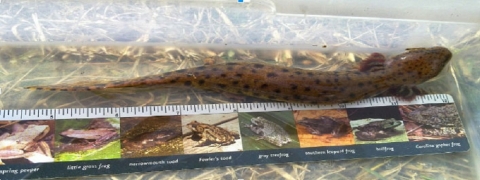The U.S. Fish and Wildlife Service finalized regulations under the Endangered Species Act (ESA) to protect the Carolina madtom a small catfish, and the Neuse River waterdog, an aquatic salamander.
The Carolina madtom will receive protection as an endangered species, and 257 river miles will be designated as its critical habitat. The Neuse River waterdog will be protected as a threatened species with an ESA Section 4(d) rule, and 779 river miles will be designated as its critical habitat.
“These animals are more than just part of North Carolina’s rich biological heritage, they are important indicator species for clean water and healthy streams, which benefit us all,” said Leopoldo Miranda-Castro, the Service’s Southeast Regional Director. “The protections afforded by the Endangered Species Act will help us support conservation efforts currently underway.”
Both the Carolina madtom and the Neuse River waterdog are found only in streams that flow into the Tar and Neuse rivers of North Carolina. Surveys show the Carolina madtom has lost 64% of its historical range, and the Neuse River waterdog has lost 35% of its historical range.
Under the ESA, species may be listed as either endangered or threatened. An endangered species is in danger of extinction throughout all or a significant portion of its range. A threatened species is likely to become endangered within the foreseeable future.
Poor water quality, reduced water quantity, and degraded and fragmented habitat are some of the reasons for the decline of these animals. Sedimentation is a widespread stressor contributing to loss or degradation of instream habitats. Both species need protection, but the Carolina madtom is facing additional stressors. The Carolina madtom is easy prey for the flathead catfish, a predator that has invaded the Neuse and Tar rivers.
Seeking to encourage private sector conservation, the Service has partnered with Conservation Fisheries Inc. (CFI) and the North Carolina Wildlife Resources Commission to breed madtoms in captivity with funding from the National Fish and Wildlife Foundation.
“We want to prevent this unique catfish from going extinct by developing techniques to propagate them in captivity. The eventual goal is to reintroduce madtoms into areas within its former range where the species has been eliminated,” said CFI’s Co-founder and Co-director J.R. Shute.
“In some areas, water quality and habitats have improved, but Carolina madtoms are unable to recolonize these areas on their own. And, the Carolina madtom is too rare to be collected from the wild in enough numbers to reintroduce into these recovered streams. This is where captive propagation becomes a valuable tool.”
Ensuring that reintroduction sites will be sufficiently healthy to support the madtom is critical. Therefore, the Service is designating 257 river miles (414 river kilometers) in seven units in North Carolina as critical habitat for the Carolina madtom. Five of the seven units are considered currently occupied by the madtom.
Research for the Neuse River waterdog is underway. As of May 2021, the Service awarded $110,000 to North Carolina State University to examine the relationship between environmental stressors and the distribution, drivers of reproduction and population viability of Neuse River waterdogs. Researchers will project how future land use may affect the species’ ability to persist in its current range.
The research will help to increase understanding of the Neuse River waterdog’s needs and inform plans for the recovery of the Neuse River waterdog. A video about Neuse River waterdog research.
The Service is also designating 779 miles (1,254 kilometers) in 18 units in North Carolina as critical habitat for the waterdog. All 18 units are considered occupied by the waterdog.
Critical habitat designations constitute the Service’s best assessment of areas that contain features essential to the conservation of the madtom and the waterdog and that may require special management and protection. The riverbanks and access areas adjacent to madtom and waterdog critical habitat are more than 90% privately owned.
Designation of critical habitat does not affect land ownership or establish a refuge, reserve, preserve or other conservation area conservation area
A conservation area is a type of national wildlife refuge that consists primarily or entirely of conservation easements on private lands. These conservation easements support private landowner efforts to protect important habitat for fish and wildlife and major migration corridors while helping to keep agricultural lands in production.
Learn more about conservation area . Activities on lands designated for critical habitat will not be affected, unless such activities are authorized, funded or carried out by a federal agency. In these cases, the government agency involved will need to consult with the Service and develop conservation measures to avoid, reduce or mitigate any impacts to the Carolina madtom and the Neuse River waterdog and/or its designated critical habitat.
Seeking to reduce potential impacts to private citizens and businesses without decreasing necessary protections for the Neuse River waterdog, the Service developed a 4(d) rule under the ESA specifying which activities are prohibited and which are allowed. During the public comment periods, the Service received comments on potential impacts to forest management practices and potential increases in regulatory burden on North Carolina’s private forestry industry. Today’s final 4(d) rule reflects key recommendations and includes careful consideration of the comments received in response to the proposed rule.
For more information, please visit the Service’s webpage on the summary of the finalized 4(d) rule prohibitions and exceptions for the Neuse River waterdog.
The final listing determinations and critical habitat designations for the Carolina madtom and the Neuse River waterdog and the 4(d) rule for the Neuse River waterdog are scheduled to publish in the Federal Register on Wednesday, June 9, 2021. The rules become effective on Friday, July 9, 2021. An early preview of the regulations will be available for public inspection on Tuesday, June 8, 2021 at 8:45 a.m. ET. After the date of publication, links to documents.




